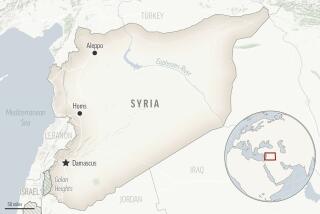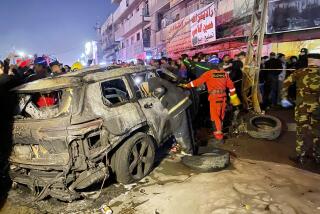Coalition airstrikes target Tripoli
The multinational coalition attacking Libya with airstrikes Tuesday night hit the nation’s capital, Tripoli, and its surroundings for the fourth time in the last several days.
At least three loud explosions, presumably coalition airstrikes or missiles, shook the earth as antiaircraft and tracer fire lighted up the sky about 9 p.m.
In central Tripoli’s Algeria Square, supporters of the regime began blowing their car horns and chanting slogans in support of Libyan leader Moammar Kadafi.
Photos: U.S., allies launch attacks in Libya
Earlier in the day, authorities took journalists on a tour of a naval port, called the People’s Port in eastern Tripoli, that was struck the previous night in an airstrike. At least six missiles had hit the site, which was filled with the charred remains of Russia-made antiaircraft launchers, surface-to-air missiles and military vehicles.
Some Libyan authorities said it was a mere training and repair facility that was not in active use. But another official said it was used to “protect Libya’s coastline” and had been employed in joint naval exercises with the armed forces of Egypt, Italy and, ironically, France, which is a leading member of the coalition attacking Libya.
Among the officers at the site, the mood was defiant. “We are not afraid of these missiles or bombs,” said navy Capt. Fahmi Sokni, 56. “We are very sad about losing our things like this. But we are still standing. We will repair it and make it whole again.”
Earlier, as the American-led air attack pounded Libya for a third day and Kadafi’s embattled forces retreated south from the rebel stronghold of Benghazi, the Pentagon said the no-fly zone soon would be extended, paving the way for the United States to eventually hand off command of the mission to its allies.
Kadafi’s forces near Benghazi “now possess little will or capability to resume offensive operations,” said Gen. Carter Ham, the officer in charge of the operation, briefing Pentagon reporters via video from his headquarters in Germany. The United States already has begun taking a smaller role in the mission, he added. Fewer than half the air missions flown Monday were piloted by Americans.
The no-fly zone will soon be expanded across the coastal north to Tripoli, Port Brega and Misurata. It is unclear to whom the U.S. will hand over the operation, though.
Europe remained divided Tuesday morning over who would eventually assume command of the mission over Libya. In London, British Maj. Gen. John Lorimer told reporters that “the operation remains under U.S. command” at the moment.
In Brussels, ambassadors to NATO reconvened a meeting to hash out the contentious issue of whether the alliance would take over from the U.S. France has expressed reservations that the Muslim world would react negatively to NATO leadership of the effort, and Turkey, another NATO member, has also opposed the idea.
Turkish Prime Minister Recep Tayyip Erdogan told his compatriots Tuesday that his country would never be party to a mission “pointing guns” at the Libyan people.
But other countries, including Italy, have insisted that the alliance take the lead.
Although the initial phase of the assault had stopped the Libyan advance on Benghazi, the larger goal of the U.S.-led operation — preventing attacks on civilians throughout the country — is a much tougher military challenge, according to current and former military officers.
As the U.S. and its allies have discovered in past conflicts, it is no simple matter to use fighters and bombers to prevent a determined adversary from targeting enemies on the ground. Even if the airstrikes succeed in halting large-scale attacks, there is the danger that Kadafi will shift to less obvious but no less deadly tactics, including the use of security forces and armed gangs to terrorize the ragtag opposition that has tried to drive him from power.
If the killing continues, the White House and its allies could face growing pressure to expand the military operation, either by broadening the list of targets struck from the air, by arming the rebels whom the U.S. admits it knows little about or by explicitly going after Kadafi in an effort to oust him.
President Obama reiterated Monday that “it is U.S. policy that Kadafi has to go.” But Pentagon officials have said the airstrikes and missile attacks have not been specifically aimed at the longtime leader.
In fact, Ham said he had received no information about the whereabouts of Kadafi. But the general added that the possibility that Kadafi might use surrogates to launch a terrorist attack outside Libya in response to the air attacks “is a very, very legitimate concern.”
In Libya on Monday, state television broadcast nonstop stock footage of steely-eyed soldiers driving tanks, launching rockets and boarding transport helicopters, suggesting that the war effort was continuing. A barrage of antiaircraft and tracer fire lighted up the sky over Tripoli, the Libyan capital, early Tuesday.
In Misurata, opposition supporters described intense combat between rebels and pro-Kadafi fighters.
“The Kadafi troops are in the main street of Misurata with their snipers,” said a doctor who asked that his name not be used to protect his family. “Our fighters are trying to fight them and finish this. Now in Misurata you can hear the sound of machine guns everywhere.”
A source in the city said nine people had been killed in the previous 24 hours, and that the injured were inundating hospitals and a major clinic.
The Obama administration has so far sought to limit its role in the air campaign and turn over command of the operation to its allies. But with forces engaged, it could become harder to resist pressure to escalate the U.S. role if the campaign does not unfold as neatly as planned.
“My concern is how does that all end,” said retired Brig. Gen. C. Jerome Jones, who was vice commander of the Air Force Special Operations Command. “We have very few, if any, historical examples of where air power can solve a political problem. And what we have in Libya basically is a political problem.”
Though U.S. commanders have described the military goal as establishing a no-fly zone since launching the effort Saturday, what they are attempting is more difficult, requiring finely nuanced judgment from fighter pilots about how to respond to multiple scenarios on the ground.
Commanders say their objective is to protect civilians from reprisals by the regime without intervening on the rebels’ side, but they also acknowledge that they are attempting to halt government attacks on remaining rebel positions, which comes close to intervening on behalf of the opposition forces.
If the rebels respond to this intervention by resuming the offensive against Kadafi’s forces, the coalition has no intention of providing air support to assist the opposition in driving the Libyan leader from power. But whereas that seems like a logical distinction now, it could become tougher to stick by if, in coming weeks, Kadafi’s power begins to crumble and the rebels regain the momentum.
“These are situations that brief much better at a headquarters than they do in the cockpit of an aircraft,” Ham acknowledged Monday.
The last time the U.S. undertook an air war largely for humanitarian purposes was in 1999, in Kosovo, a tiny province in Serbia where police and military forces loyal to Yugoslav leader Slobodan Milosevic were carrying out a ruthless assault on ethnic Albanians.
Clinton administration officials expected Milosevic to fold quickly after NATO launched airstrikes, but it took a 78-day bombing campaign. As Obama has done with Libya, the Clinton White House vowed early on not to send U.S. ground troops into Kosovo, which seemed to only embolden Milosevic to resist.
Officials at the Pentagon on Monday said that the Libya operation was going as planned.
Having neutralized much of Libya’s air defense system, the coalition will focus in coming days on extending the no-fly zone, Ham said, gradually bringing more and more cities along the Libyan coast under air protection. If all goes according to plan, U.S. military officers say, there will be several more weeks of air attacks, largely by British, French and other countries’ fighters.
Simply keeping watch on those Libyan forces will become tougher as more of the country falls under the no-fly zone. “This is by no means over,” a senior U.S. officer said Monday. “Kadafi still has ground forces and we still believe that he intends to use them.”
Photos: U.S., allies launch attacks in Libya
Times staff writer Borzou Daragahi in Tripoli and Ken Dilanian of the Washington bureau contributed to this report.
More to Read
Start your day right
Sign up for Essential California for news, features and recommendations from the L.A. Times and beyond in your inbox six days a week.
You may occasionally receive promotional content from the Los Angeles Times.







